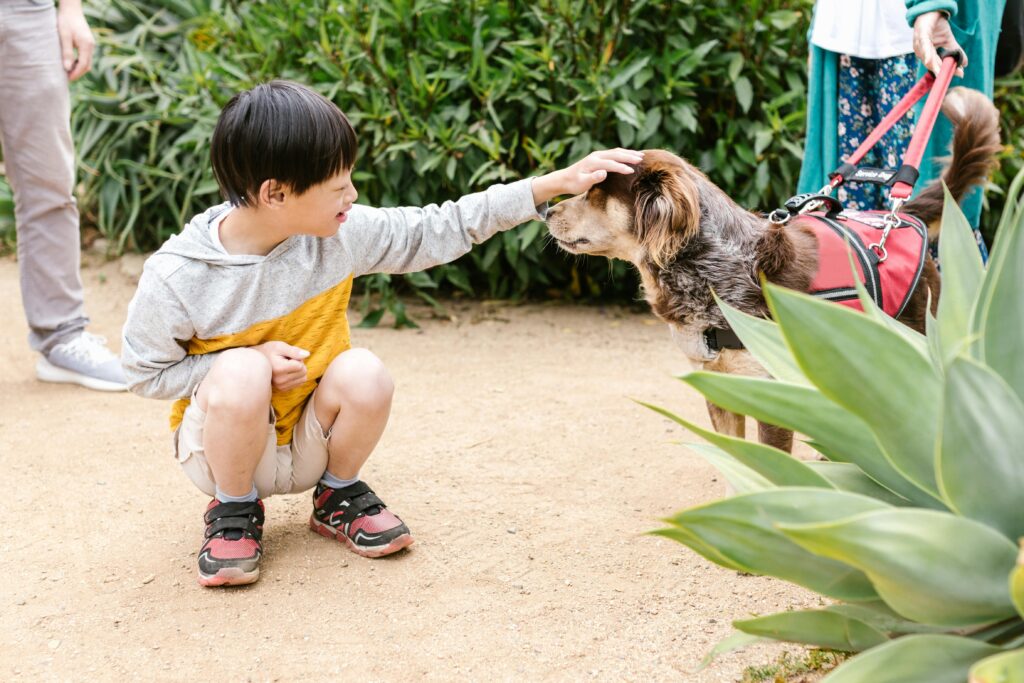
Therapy dogs bring comfort, joy, and emotional support to people in various settings, from hospitals and nursing homes to schools and disaster areas. However, not every dog is suited for this demanding and rewarding role.
Determining if your dog has the necessary traits to be a therapy dog involves evaluating their temperament, behavior, and training potential. Here’s a closer look at the key qualities needed for a dog to excel as a therapy dog.
Temperament Matters
A therapy dog must possess a stable and calm temperament. They need to be friendly, patient, and gentle, with an inherent ability to remain composed in diverse and potentially stressful environments.
Dogs that are naturally aggressive, overly shy, or highly excitable may struggle in this role. Instead, look for dogs that show a natural inclination to approach and engage with people positively. They should enjoy being petted and handled, even by strangers, and display a keen sense of empathy.
Socialization Skills

Socialization is crucial for a therapy dog. From a young age, the dog should be exposed to various people, places, and situations to ensure they are comfortable in different environments. Therapy dogs often work in bustling and unpredictable settings, so they need to be adaptable and unflappable.
Dogs that are well-socialized are less likely to be startled by sudden noises, movements, or unfamiliar objects. They should also get along well with other animals, as therapy sessions might involve interactions with other pets.
Obedience and Training

Basic obedience is a foundation for any therapy dog. They must reliably respond to commands such as sit, stay, come, and heel. A therapy dog should walk calmly on a leash without pulling, jumping, or displaying disruptive behavior.
Advanced training can include learning how to navigate crowded spaces, ignore distractions, and maintain composure during prolonged periods of inactivity. Training should also focus on positive reinforcement techniques to ensure the dog associates their tasks with positive outcomes.
Health and Hygiene
Health and hygiene are paramount for a therapy dog. They must be in good health, free from contagious diseases, and regularly groomed to maintain a clean and pleasant appearance.
Regular veterinary check-ups are essential to ensure the dog is fit for therapy work. Additionally, therapy dogs should be well-groomed, with trimmed nails and clean coats, to ensure they are pleasant to touch and to prevent any potential transmission of allergens or pathogens.
Emotional Resilience
Therapy dogs often work with individuals who may be experiencing significant emotional or physical distress. Therefore, emotional resilience is a critical trait.
Dogs should be able to handle being around people who might express strong emotions, such as crying, yelling, or sudden movements, without becoming anxious or scared. They should also be able to endure extended periods of interaction without showing signs of stress or fatigue.
Certification and Ongoing Assessment
Once you believe your dog has the necessary traits, the next step is certification. Programs typically involve temperament testing, obedience assessments, and evaluations of the dog’s behavior in various simulated therapy settings. Even after certification, regular assessments are recommended to ensure the dog continues to meet the high standards required for therapy work.
Read more: Dog Certifications: How Do They Help Owners?
Conclusion
Not every dog is cut out to be a therapy dog, but those with the right mix of temperament, socialization, training, health, and emotional resilience can make a profound impact on the lives of the people they help.
If you think your dog has what it takes, consider pursuing the necessary training and certification to embark on this fulfilling journey together. The rewards, both for the recipients of the therapy and for you and your dog, are immeasurable.
Need to know more about companion and assistance animals? Read these articles!
- The Power of Advocating for Emotional Support Animals
- Why Do Our Pets Make Us Feel Good?
- How Do You Tell if a Dog Would Be a Good Service Dog?
Do you own an assistance animal? Register your pet today. The Service Animal Registry of California invites you to have your assistance animal registered in order to designate its status. We also encourage you to take our online classes so you can be fully aware of your rights and gain more knowledge about your support animal.
Finally, we present to you our book entitled, “ASSISTANCE ANIMAL LAWS: LEARN YOUR RIGHTS REGARDING SERVICE ANIMALS, EMOTIONAL SUPPORT ANIMALS, THERAPY PETS, AND OTHER DOGS, CATS, AND ASSISTANCE ANIMALS” to provide you with a complete education on assistance animals. Purchase your copy of the book by clicking the image below.




























